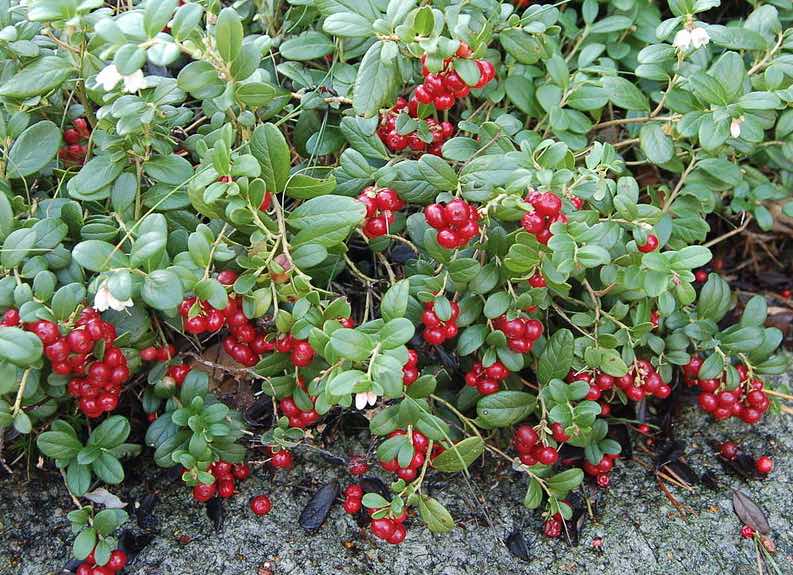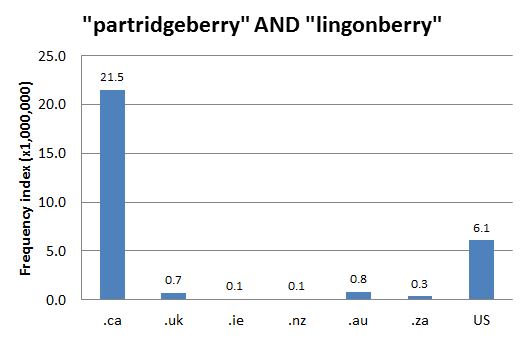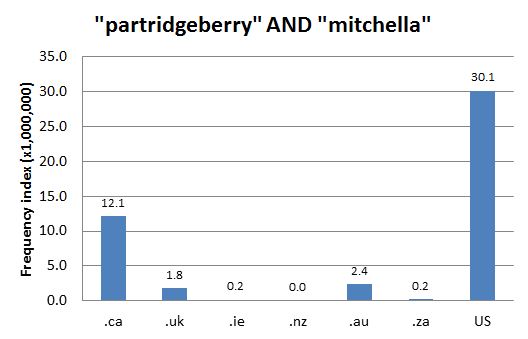DCHP-2
partridgeberry partridge berry, cowberry, lingonberry DCHP-2 (October 2016)
1a n. — Newfoundland, Flora
a short evergreen shrub; known as lingonberry in Europe; Vaccinium vitis-idaea var. minus (see Image 1).
Type: 5. Frequency — Three common North American evergreen plants -- Mitchella repens, Gaultheria procumbens and Vaccinium vitis-idaea var. minus are referred to as partridgeberry (OED-3, s.v. "partridgeberry"). The term partridgeberry derives from the habit of partridges and other birds of eating the berries in the winter (DARE, s.v. "partridgeberry"). Vaccinium vitis-idaea var. minus, a wild subspecies of a species that is cultivated in Europe as the lingonberry, has long played an important role in Newfoundland and Labrador's economy. The province is the largest North American producer of this fruit (Penney et al. 1997: 139). The particular variety mentioned here, and its name, are native to North America (see Chart 1). According to a regional language study done in the province, the use of partridgeberry for this genus is exclusive to Newfoundland (see the 1987 quotation). As Chart 2 indicates, Mitchella repens is prominent in the US, which suggests that Vaccinium vitis-idaea var. minus is the more prominent Newfoundland variety.
See also OED-3, s.v. "partridgeberry" (1c), which is marked "Newfoundland".See also: redberry
1b n. — Newfoundland, Flora
the edible red berry of the Vaccinium vitis-idaea var. minus (see meaning 1a).
Type: 5. Frequency — The fruits are most often used to make jam or some kind of baked dessert (see the 1992 quotation). The partridgeberry industry has been a vital part of Newfoundland's economy for over a century (see the 1886 quotation) (see meaning 1a). The berry is also harvested in Manitoba, Saskatchewan and Nova Scotia. In the latter province it is known as the foxberry (Hendrickson 1997: 47).See also: foxberry pheasantberry
2 † n. — Flora
a trailing evergreen shrub, Mitchella repens, having roundish leaves and white blossoms.
Mitchella repens is a North American shrub that is also referred to as partridgeberry, but this species does not have the cultural or historical significance of Vaccinium vitis-idaea var. minus (see meanings 1a, 1b).See also: twinberry
- Though this usage of partridgeberry can be seen across North America, it is most prevalent in the US (see Chart 2).
References:
Images:

Image 1: A partridgeberry shrub (Source: Wikimedia Commons. Photo: Arnstein Rønning)
Chart 1: Internet Domain Search, 13 May 2014
Chart 2: Internet Domain Search, 13 May 2014

